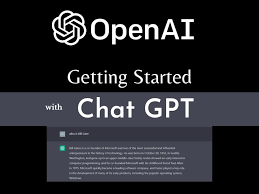In the current fast-paced digital age, the significance of content development has dramatically expanded. Your success as a blogger, marketer, or content creator hinges on your capacity to produce excellent works that pique readers’ interests and impart knowledge. Unfortunately, it can be difficult and time-consuming to regularly provide fresh and interesting material. Fortunately, you can improve the quality of your content and speed up the article writing process with the use of technology. This essay will examine how to swiftly and effectively produce high-quality articles using ChatGPT, a cutting-edge language model. We’ll provide you with a thorough tutorial on how to use ChatGPT for article writing, as well as share advice on how to make the most of this effective tool.
Understanding ChatGPT
ChatGPT is a state-of-the-art language model developed by OpenAI, an artificial intelligence research laboratory. It is trained on a massive corpus of text data and can generate human-like text based on the input it receives. ChatGPT is a deep learning model that uses a transformer-based architecture to generate text. It is capable of generating text in a variety of formats, including natural language, code, and tables, and can answer questions and complete prompts.
To ensure that it can produce accurate and pertinent material, the model is trained on a wide variety of texts, including books, papers, and web pages. ChatGPT is the perfect solution for content writers who need to produce high-quality articles fast and effectively since it can generate writing that is clear, fluent, and grammatically correct.
Although ChatGPT is a potent tool for creating content, it is crucial to highlight that it has some drawbacks. The model may sometimes produce inaccurate or irrelevant content, especially if the input it receives is incomplete or ambiguous. Additionally, it is not capable of understanding the context or emotions behind the text it generates, which can sometimes lead to the production of insensitive or inappropriate content.
ChatGPT is a cutting-edge language model that has the potential to revolutionize the way we generate and consume content. By understanding its capabilities and limitations, we can use it effectively to create high-quality articles that engage and inform our audience.

Setting Up ChatGPT
Before you can start using ChatGPT for article writing, you need to set it up and configure it to suit your needs. There are several ways to access ChatGPT, including OpenAI’s API and third-party applications. Here’s how to set up ChatGPT:
Sign up for OpenAI API access: To access ChatGPT through OpenAI’s API, you need to sign up for an API key. You can accomplish this by going to the OpenAI website and following the sign-up page’s instructions.
Choose a third-party application: Several third-party applications allow you to access ChatGPT without using OpenAI’s API directly. Some popular options include Hugging Face’s Transformers library, which provides a Python interface for working with ChatGPT, and GPT-3 Sandbox, which offers a user-friendly web interface for generating text.
Install the necessary libraries: Depending on which method you choose to access ChatGPT, you may need to install additional libraries or dependencies. For example, if you’re using Hugging Face’s Transformers library, you’ll need to install PyTorch or TensorFlow.
Configure ChatGPT settings: Once you’ve set up ChatGPT, you’ll need to configure its settings to suit your needs. This includes setting the temperature, which controls the randomness and creativity of the generated text, and the length of the generated text.
Test and refine: Once you’ve set up and configured ChatGPT, it’s a good idea to test it out and refine your settings as needed. Start by generating short snippets of text and gradually increasing the length and complexity of the prompts to get a feel for how the model works. Refine your settings based on the quality and relevance of the generated text.
By following these steps, you can set up ChatGPT and configure it to generate high-quality articles quickly and efficiently. Remember to keep in mind the model’s capabilities and limitations and adjust your settings accordingly to get the most out of this powerful tool.
So, How to Use ChatGPT for Article Writing?
Using ChatGPT for article writing can save you time and effort while producing high-quality content. Here are some tips on how to use ChatGPT effectively for article writing:
Generate article ideas: Use ChatGPT to generate ideas for articles. You can give it a broad topic or a specific question to generate ideas that you can then develop into full articles.
Generate article outlines: Use ChatGPT to generate article outlines based on your topic or keywords. This can help you structure your article and ensure that you cover all the necessary points.
Refine generated content: While ChatGPT can generate high-quality content, it’s important to refine it to ensure it’s relevant and accurate. Use your knowledge and expertise to refine the content generated by ChatGPT.
Incorporate personal style: While ChatGPT can generate grammatically correct and coherent content, it may not be able to replicate your writing style. Use the generated content as a starting point and incorporate your writing style to make it unique.
Incorporate keywords: Use ChatGPT to generate content that includes important keywords related to your article topic. This can help with SEO and ensure that your article is relevant to your target audience.
By using ChatGPT for article writing and SEO, you can save time and effort while producing high-quality content. Remember to refine the generated content and incorporate your style to make your articles unique and engaging.
Other Tips and Tricks
In addition to the tips mentioned above, here are some other tips and tricks for using ChatGPT effectively for article writing:
Use high-quality prompts: The quality of the prompts you provide to ChatGPT will directly affect the quality of the generated content. Use clear and concise prompts that are relevant to your article topic and include important keywords.
Train ChatGPT with your content: If you have access to large amounts of relevant content, consider training ChatGPT with your data. This can help improve the relevance and accuracy of the generated content.
Experiment with temperature settings: The temperature setting controls the randomness and creativity of the generated text. Experiment with different temperature settings to find the right balance between creativity and accuracy.
Use a human editor: While ChatGPT can generate high-quality content, it’s important to have a human editor review and refine the content. This can help ensure that the content is accurate, relevant, and engaging.
Keep up with current events: ChatGPT can generate content on a wide range of topics, but it’s important to keep up with current events and trends to ensure that your content is timely and relevant.
By using these tips and tricks, you can make the most of ChatGPT for article writing and produce high-quality content quickly and efficiently. Remember to continually refine your approach and experiment with different settings to find what works best for you.
ChatGPT is a powerful tool for article writing that can help you save time and effort while producing high-quality content. By following the tips and tricks mentioned above, you can use ChatGPT effectively and efficiently to generate ideas, outlines, and content for your articles. Remember to refine the generated content, incorporate your style, and experiment with different settings to get the most out of this powerful tool. With ChatGPT, you can take your article writing to the next level and produce engaging and informative content for your readers.
FAQs:
Q: What is ChatGPT?
A: ChatGPT is a large language model developed by OpenAI that uses deep learning algorithms to generate human-like text. It can be used for a wide range of applications, including article writing.
Q: How to use ChatGPT for article writing?
A: ChatGPT can be used to generate article ideas, outlines, and content based on your topic or keywords. It can save you time and effort while producing high-quality content.
Q: Is the content generated by ChatGPT accurate and relevant?
A: While ChatGPT can generate high-quality content, it’s important to refine the generated content and incorporate your own knowledge and expertise to ensure accuracy and relevance.
Q: Can ChatGPT replicate my personal writing style?
A: ChatGPT can generate grammatically correct and coherent content, but it may not be able to replicate your personal writing style. It’s important to incorporate your own writing style to make the content unique and engaging.
Q: How can I ensure that the content generated by ChatGPT includes important keywords?
A: You can provide ChatGPT with specific keywords or topic-related prompts to ensure that the generated content includes important keywords. This can help with SEO and ensure that your article is relevant to your target audience.
Q: Can I train ChatGPT with my own content?
A: Yes, if you have access to large amounts of relevant content, you can train ChatGPT with your own data. This can help improve the relevance and accuracy of the generated content.
Q: Should I use a human editor to review the content generated by ChatGPT?
A: Yes, it’s recommended to have a human editor review and refine the content generated by ChatGPT to ensure accuracy, relevance, and engagement.
If you feel our tips and tricks are useful before you leave, please help the site with a small action like voting or sharing with everyone to grow faster and serve you better. Thank you and best wishes.



![Async Await c# Error Handling [SOLVED!]](https://mycodebit.com/wp-content/uploads/2023/10/rich-tervet-q2GNdFmhxx4-unsplash-360x240.jpg)

![How to Handle Divide by Zero Error in c# [Complete Guide]](https://mycodebit.com/wp-content/uploads/2023/10/clement-helardot-95YRwf6CNw8-unsplash-360x240.jpg)
